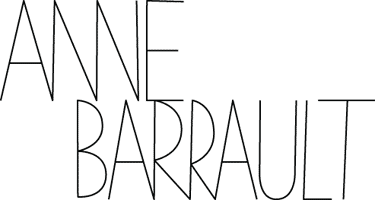Lick a toad and paper-cut your tongue
Lick a toad and feel happy
Lick a toad and the hole in your shoe is a silver Gucci
Lick a toad and get two minutes
Lick thick thread and tremble around the spheres of action[1]
Lick the Toad gathers artworks, objects, and ephemera, as fragments of vulnerability, dreams, and social alienation. The title takes a line from “Lots”(2013), a poem by artist and author Tiziana La Melia, which draws on notions of fate and fairy tales, energized by stories such as those of laborers spinning wool all night to keep them awake while working. Similarly, with an anti-capitalist and hallucinatory impetus, the exhibition disrupts dominant narratives of marginalisation, value and care. In channelling the fiction of the self and society, toad licking becomes an acid-like gesture, corrosive to the functionality and the homogeneous, stripping away illusions to reveal the raw facets of situated narratives and personal traumas. By interfering with the realms between consensual reality and autofiction, altered states of consciousness and historical facts, the works operate on a mode of understanding that engages with the world through correspondences and metaphors, by a kind of poetry that handles bits and pieces in the dormant forces and realities of life.
Free associations and ramblings permeate the intuitive language of Anne Bourse, shaped by experiences of dissociation and appropriation, assemblages and folds. Grounded in a ghostly vision of learning and creation, and often with a pastel palette, a sense of freedom and innocence runs through Nile Green Bench (2024), simultaneously minimalist and fragile, conceptual and object-furniture. The artist honours the minor art made with thread and textile, presenting Dismorphic Golden Bench (2024), a hand-woven bench made of golden fabric. The work evokes hypnagogic hallucinations—those fleeting, dreamlike states between wakefulness and sleep—during which the artist, as a child, frequently experienced a distorted sense of body, such as unusually elongated arms and legs. Her hand-crafted books, imperfectly copied, glued, drawn, and printed, fuse paint, pencil, pen, and fragments of ungraspable signs blend with digital impressions, such as in Adorables Cochons d’Inde, 2018 (an epileptic seizure in the Guinea Pig version of Brain, a journal of neurology). Colourful writings and spontaneous scribbles are suspended between arabesques and automatisms, asemic writing and communication.
Notions of mental health, subcultures, and fantasy inform Tania Gheerbrant’s installation, whose practice is rooted in historical research. In Alliteration (2025), the artist creates an ephemeral and poetic scenography of posters and verses through silkscreen prints on delicate materials such as fabric, paper, and mirrored foil. Slogans stretch across the posters on the walls, merging with the rhythmic murmur of poems and spoken word from the installation’s videos. For the past few years, Tania Gheerbrant has been working with members of the “Réseau des Entendeurs de Voix”, a community, founded in the Netherlands in 1988 and emerged in France in 2011, which offers non-medical spaces for sharing and self-care outside institutional psychiatry, and gives voice to patients as a form of therapy. Inviting viewers to explore documents and witnesses on anti-psychiatric movements, these materials offer a counter-history of madness, unfolding the pervasive mechanisms of alienation within a disciplinary society. She also creates a space for listening to the voices of patients, suggesting how storytelling and imagination can fuel collective resistance beyond the norms of social control.
Tiziana La Melia fools the convention of perception and communication, by addressing how class, identity and immigration shape not just lives, but also bodies and gestures operate within systems of power structured by language. The artist’s writing and visual approach conjures memories, experiences, objects, and food towards fables, poems, and personal mythologies, such as in Conditions, 2025. In this piece, the footage from the weather webcam intertwines with a poem that serves as a recipe for mending a broken heart. The spolvero[2] drawing refers to a character in the fable drama series Country Mouse City Mouse Hamster[3](CMCMH), a roving, episodic project that navigates between rural and urban life, migration and belonging. In the Tabloid series, film stills, behind-the-scenes images, drawings, and research from the CMCMH video are collaged onto canvas and velvet, in moments embellished with pigment, tinted sunscreen and crystals Here, the triptych format recalls the shape of a tabloid—referring to the compressed form of medicine sold in tablets. Recognized today as the lurid broadside paper featuring sensational stories. Shaped like a cross, it echoes the pharmacy symbol, suggesting how storytelling may function as a form of mending. The language of her videos, performances, poems, sculptures, paintings and drawings overcomes any empirical dimension, destabilizes the laws of linear logic, lying in evocative and almost psychedelic semiotic realms.
Sonia D’Alto
[1] Tiziana La Melia,“Lots”, in I Come from a long line of people who don’t use words, edited by Sonia D’Alto, Archive Books, 2025, p. 34.
[2] “Spolvero” (Italian for “dusting”) is a technique, commonly used for fresco, where a design is transferred by punching holes along its outline and dusting pigment through them to create a dotted trace,
[3] Video montage of 60 min, digital film shot on DVCAM, 2021/25.
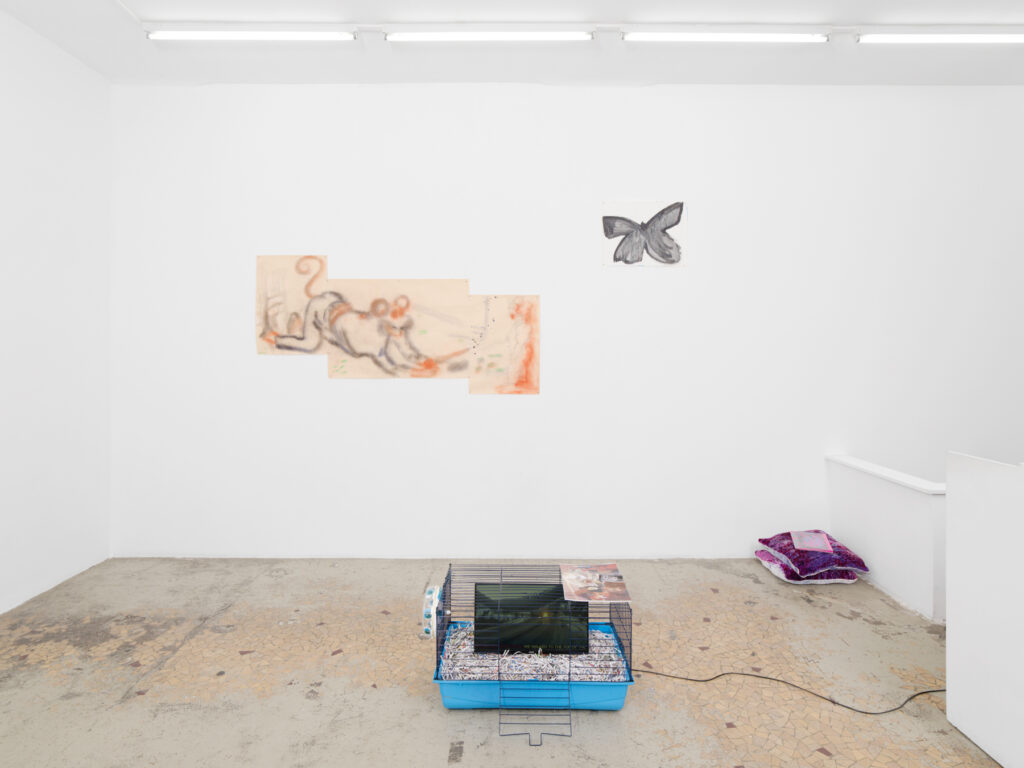
exhibition view Lick the Toad with works by Tiziana la Melia & Anne Bourse
(photo Aurélien Mole)
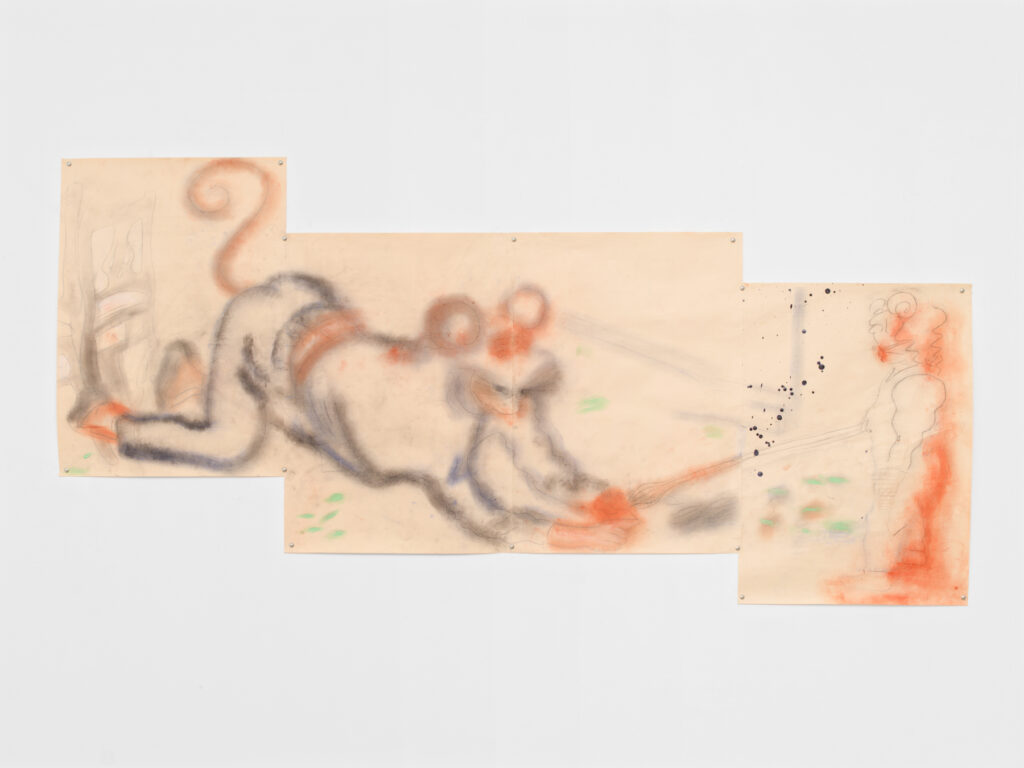
Tiziana La Melia
Sweeping Almonds, 2025
Sinopia, pastel, charcoal, and ink on spolvero paper
93 x 200 cm
(photo Aurélien Mole)
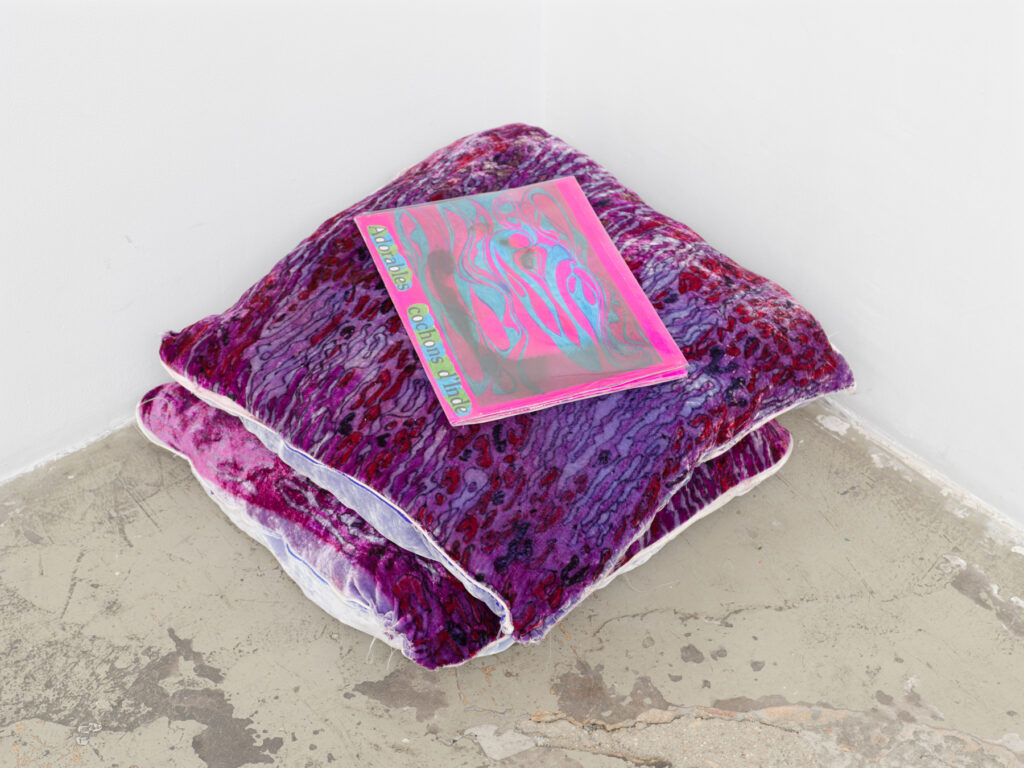
Anne Bourse
Charlotte’s skirt pillows, 2025
alcohol felt, ink on silk velvet, thread, wadding, piping
47 x 50 x 10 cm chaque coussin
(An epileptic seizure in) Adorables cochons d’Inde, 2018
ink, ballpoint pen and print on coated paper, 36 pages, laminated cover
(photo Aurélien Mole)

exhibition view Lick the Toad with works by Tiziana la Melia & Anne Bourse
(photo Aurélien Mole)
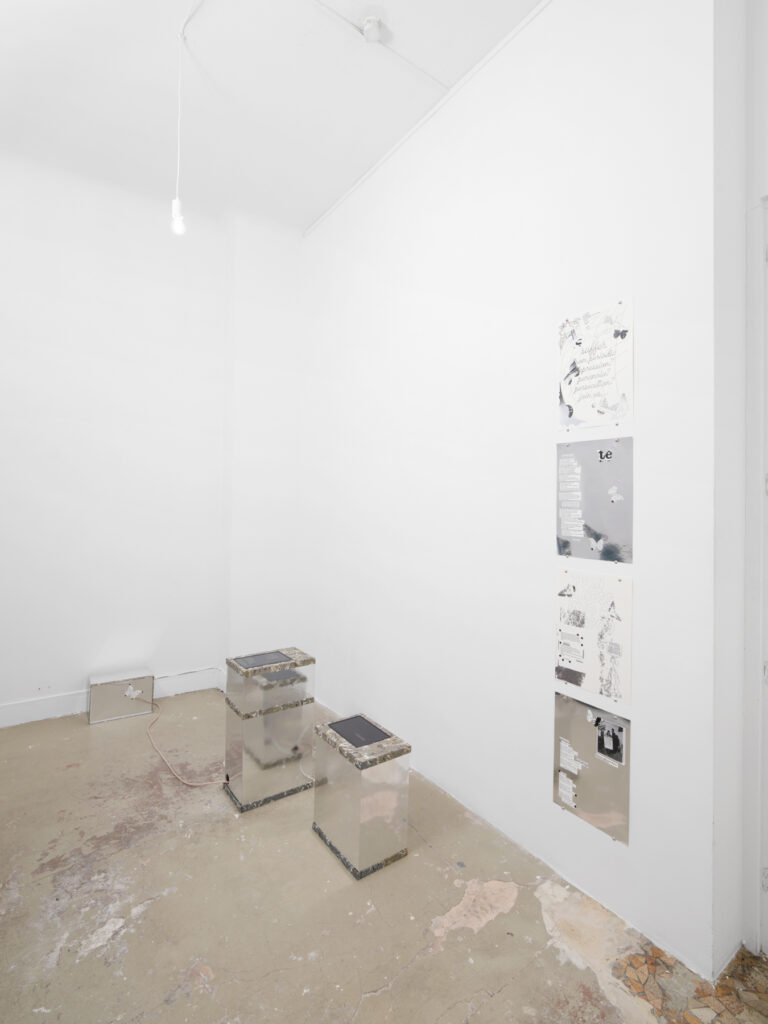
exhibition view Lick the Toad with works by Tania Gheerbrant
(photo Aurélien Mole)
_____
Sonia D’Alto is an art historian, curator, and writer. Her research and curatorial practice explore the connections between superstition and modernity, folklore and taxonomies of power, through feminist gestures, decolonial magical practices, and subaltern cosmologies. She has worked on these topics with institutions such as the Venice Biennale, Museo Madre (Naples), documenta studies (Kassel), Villa Arson (Nice), De Appel (Amsterdam), AWARE (Paris), and Frame Finland (Helsinki). Her writings have appeared in journals such as e-flux journal, NERO, Flash Art, Mousse, and Critique d’Art. She is currently a PhD candidate at HFBK Hamburg, and she lectures in the Curatorial Studies department at the Royal Academy of Fine Arts (KASK) in Ghent. A book she has curated on Tiziana La Melia’s poetry practice is forthcoming with Archive Books, and she is currently working as the curator of the first monograph on Le Nemesiache for Mousse Publishing.
_____
Tiziana La Melia lives on the unceded territories of the xwməθkwəy̓ əm, Sḵwx̱wú7mesh, and səl̓ílwətaʔɬ peoples (Vancouver, CA). In her writing and art practice, Tiziana gleans the detritus of the everyday and transmutes it into material textures, and iterative shapes and symbols, which move through layers of diasporic time. Current and recent exhibitions of work can be seen at: Country Mouse City Mouse Hamster, Or Gallery, Vancouver (2025); Town & Country: Narratives of Property and Capital, The Belkin (2025); we know nothing about people who don’t cry, Romance, Pittsburgh (2025). Recent publications include lettuce lettuce please go bad (Talon Books, 2024); the poetry album Kletic Kink (Tenderly, 2022); The Eyelash and the Monochrome(Talon Books, 2018). She is the recipient of the 2014 RBC Painting Prize.
_____
Tania Gheerbrant lives and works in Zurich and Paris She graduated from the Beaux-Arts de Rennes in 2014 and the Beaux-Arts de Paris in 2017. Her work, based on long-term research, mainly takes shapes in installations, videos and printed matters.
She is particularly interested in the history of psychiatric institutions and the anti-psychiatry movement. By developing a filmic, visual and graphic practice she leads her research on listening and care into plastic forms.
She regularly takes part in institutional group exhibitions, including: Palais de Tokyo (2024-FR); Frac Bretagne (2024-FR); Bally Foundation (2023-CH); Chapelle des Beaux-Arts de Paris (2022-FR); 66th Salon de Montrouge (2022-FR); Le Point Commun (2021-FR); Fondation Fiminco (2021-FR); Palais des Beaux-Arts de Paris (2021-FR); La Panacée MoCo, Montpellier (2019-FR); La villa Radet (2019-FR); The Other Art Fair, Turin (2018-IT).
Her work is also shown in solo exhibitions in France and abroad: Salzburger Kunstverein (upcoming – solo – AUT), kulturfolger-Zurich, Hybridbox of Hellerau (2023-DE), Ateliers Vivegnis International (2022-BE), Cité Internationale des Arts (2021-FR), and in duos at Mains d’Oeuvres (2023-FR), Paris Czech Cultural Center (2020-FR).
Her videos have been screened in different institutions and art spaces such as: AWARE, Archives of Women Artists, Research and Exhibitions (2023-FR), the HKV Berlin in the program of Culture d’avenir of the Centre Pompidou (2022-DE), in the CCC OD (2021-FR) , and at the Echo Park film center in Los Angeles (2020-US).
She has been the recipient of fellowships, residencies and prizes, including in 2024 Art Norac Prize and Mécène du Sud. Her latest works have been commissioned by the Palais de Tokyo, the Bally fondation or supported by the DRAC île-de-France (regional cultural affairs department).
______
“My practice is inhabited by elective affinities that make up the fictional community in which I work. Let’s say I’m a language interspeciesist with a slightly perverse bent. I address someone with something in order to secretly talk to someone else.”
Anne Bourse
Anne Bourse was born in Lyon in 1982. She lives and works in Saint-Denis.
Of Anne Bourse’s work, swirling lines and letters that look like they came out of burlesque cartoons or psychedelic frescoes invade the surface of books, clothes and papers of all kinds. Although her practice is declined in different mediums, among which painting, drawing, as well as textile or textual productions, it is above all punctuated by the continuous movement of a writing of the self.
Recent solo exhibitions include: Musée d’art moderne et contemporain de Saint-Étienne Métropole (MAMC+) (FR), Kunsthalle Bremerhaven (DE), Galerie Édouard Manet, Gennevilliers (FR), Crèvecoeur, Paris (FR), MOCO La Panacée, Montpellier (FR) – with Mimosa Echard.
Her work has been shown in numerous group exhibitions, including 24e Prix Fondation Pernod Ricard, Paris (FR), Palais de Tokyo, Paris (FR), Villa Empain, Brussels (BE), Frac Corsica, Corte (FR), Scheusal, Berlin (DE), Crédac, Ivry-sur-Seine (FR), CAC Brétigny, Brétigny-sur-Orge (FR), Frac Île de France, Paris (FR).
Anne Bourse is represented by galerie Crèvecœur in Paris.
She is currently presenting a solo exhibition at Crevecœur, until July 19, 2025.
